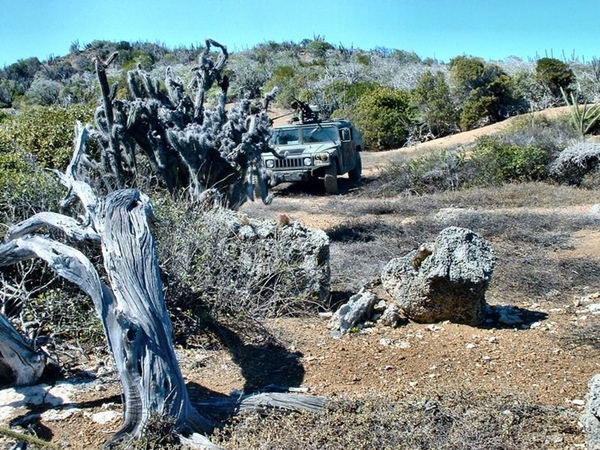In February 2004, David J. Evans, a marine biologist and photographer,
was engaged as part of a team working on the Pentagon’s
Legacy Program, which documents the cultural and
environmental aspects of Defense Department operations. His assignment
was to survey and photograph the rich array of wildlife and
vegetation at Guantánamo Naval Base. After publication of “The
Guantánamo ‘Suicides,’” Evans contacted me. “I’ve seen the facility
described in your article as ‘Camp No,’” he said, “and I can confirm
that the description of its position and appearance is accurate.”

One day near the end of his stay, Evans set out from Camp Delta in the company of a co-worker and two civilians from the Naval Facilities
Engineering Command, moving uphill in their Humvee onto a ridge. “Moving up onto the ridge was hairy,” Evans told me, “there were
thorny trees and bushes brushing up against the vehicle. The trail going up was formed by use, it wasn’t a proper road.” When they reached the crest, Evans saw the facility, not much more than a mile north of Camp Delta.
The team’s objective was to map the points of convergence between various vegetation zones, and so they had a GPS device with them. But they decided not to use it. “We were told not to photograph it, and discouraged even from looking at it,” he said. “But we couldn’t resist looking.”
“Working all around the Guantánamo base, I came across a number of old structures, some defunct and abandoned,” Evans said. “But this was something that had obviously been built pretty recently. Moreover, it looked a lot like the other prison camps I had seen.” Evans caught more glimpses of the facility as the team continued its work. “There didn’t seem to be any windows in the facility,” he said.
Evans says he doesn’t know how the facility was used, but it was carefully positioned so that it couldn’t be detected by casual visitors to
the base or to the detention camps.
Evans says he left the island a few days later, puzzled by the
facility in the hills. It obviously was connected to the prison camp
in some way, he thought. Why had a detention facility been constructed
in this rugged corner just out of sight and just out of hearing from
the base? “There was a lot of tension associated with that place,” he
noted. “Our escorts didn’t want to talk about it and behaved as if it
didn’t exist, even though it was right there.”
During his visits to Guantánamo, Evans says that some of the guards did tell him
about the harsh treatment to which some of the prisoners were
subjected. They talked about it with a degree of glee, Evans observed.
“It was a bit disturbing.” But Evans sharply discounts another aspect of Guantánamo’s reputation.
“They call it a dry, dusty, desolate place,” he said. “That’s nonsense.
Guantánamo Bay is a place of great natural beauty, a treasure, it
could easily be a national park.”


